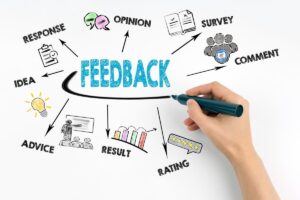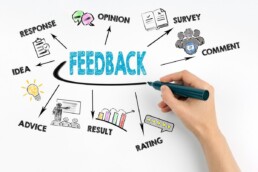Does Your Client's Company Performance Reflect their Goals?
A successful company sets goals that mirror their vision, purpose, and mission, and their performance should reflect their goals.

When the company’s goals are aligned with the overall vision, purpose, and mission, the company can make the most impact. Additionally, company performance is built and sustained by the goals that are set.
While many companies focus on setting performance goals, if the performance does not reflect the goals, it could affect the future growth and prosperity of the company.
So, how do you and your client know when performance is reflecting their goals?
Know what the company is capable of.
To understand the full extent of how your client’s company performance should reflect their goals, you and your client must be able to make sense of how all areas of the business are interconnected and capable of meeting expectations. In other words, is the business ready to hit certain growth targets?
First, assist your client in reviewing the company's mission statement and strategic plan to identify key priorities and objectives. Then break down those objectives into specific, measurable goals that can be assigned to individual employees, teams, or departments.
Recognize that peak performance is influenced by many factors including new recruitment, training, equipment, financials, technology, economics, etc. For example, it is critical to consider how recruiting goals of qualified talent will impact customer service goals, which impact productivity goals, which impact revenue goals, and so forth.
If one area of your client’s business is not ready or capable of meeting targets, it can prevent other areas of the business from meeting their targets. This can affect the entire company.
Take a moment to understand that your client’s business has limitations just like any other company. Some things they can control and others they cannot. Those things that can be controlled might require a shift in company resources, such as adjustments to overhead costs, to align the company’s performance with the goals. For those things that cannot be controlled, encourage your client to be flexible until the company can acquire the resources needed or has more time to adjust to the shift.
Ensure everyone is working toward the same collective goals.
For the company to be successful, it is important that the shareholders, management, and employees work toward the same collective goals. For example, while every employee should have their own individual performance goals, they must also be aware of how their performance is a pivotal part of the overall performance of the company. Their goals directly impact the company’s goals.
Your client and their leadership team must clearly and concisely communicate the objectives, goals, and strategies to ensure that shareholders, management, employees and clients are all on the same page. It is only when everyone is fully aware of the company’s objectives, goals, and strategies that they can provide the best contributions toward the success of the company.
Gauge how effective improvement efforts are on the company.
The purpose of gauging the company's performance is to determine what is being done well and where improvements can be made. Gauging how well the business is performing, in addition to how effective improvement efforts are over time, is essential for you and your client to know whether their company’s performance reflects their goals.
This involves regularly checking the progress towards these goals and adjusting them as needed to ensure they remain relevant and aligned with the company's objectives. Some main areas to monitor might include productivity, finances, sales, industry benchmarks, customer satisfaction, and employee feedback. Additionally, your client will want to analyze year-to-year performance carefully.
While you might be focused on identifying problem areas that are underperforming, it is also important to remind your client to celebrate progress and successes along the way.
Gauging company performance to reflect goals can be a daunting task. To ensure your company’s performance reflects the goals, it is critical that you and your client learn to use different indicators. The Profit Enhancer Analysis provides consultants with the tools needed to monitor relevant indicators to effectively grow a successful business. Contact us to learn more.
Analyzing the Performance Problem
As a consultant working with your clients to improve company performance, one of the most important things you do is assist them in analyzing performance problems. You and your client’s ability to analyze what is going on with performance and gain insights into a problem can guide improvements.
Measuring performance provides your client with the basis for improving, but until something is changed, the problem could prevent your client from getting favorable results. But, before you can decide what improvements to make, you must first analyze the performance problem.

To understand more about analyzing performance problems, let’s look at 6 steps for analyzing the problem in more detail.
6 Steps to Analyze the Performance Problem
1. Review your revenue variances.
An effective approach to analyzing performance problems is to track progress using metrics and goals. Financial reports provide a way to track the progress of your income, revenue, expenses, etc. Your client should be performing a regular review of financial reports that includes comparing the company’s actual revenue to projections.
Projections are a financial representative of your client’s goals. Essentially, what you are doing when comparing revenue to projections is comparing variances in what the company did in a specific period to what the company had set out to do for the same period. Variances are usually reported in dollar amounts or percentages.
It is also helpful for your client to review variances from period to period and year to year to show how the business is performing during different seasons and annually, respectively. Also, review the variables across different areas, departments, and product and service lines.
By tracking the progress of the company’s performance, you and your client can recognize that there are problems that need improvement.
The problems will become evident where variances in the actual revenue compared to the projections are significant. The problems could signal underperformance, cost control, lack of sales, or something else. But do not jump to conclusions. A tool like the Profit Enhancer Analysis will give you the further investigation required to help you and your client evaluate the reason behind the problem.
2. Research potential reasons for variances.
Accurate identification of the performance problem is crucial before you can determine what you need to improve. Your variance analysis can help you identify where the problem exists in terms of department, product, service, process, or other place in your company. However, more research is necessary to identify if you have an internal or external problem.
Internal problems to investigate include staffing shortages, technology issues and upgrades, and equipment downtime. External problems to investigate include increases in vendor expenses, availability of materials and supplies, seasonal issues, weather and economic trends. These are by no means complete lists of internal and external problems, just examples.
3. Review non-financial factors.
It could be helpful to go back to non-financial factors from your projections and review them in greater detail. These could be processes and numerical information that were used to determine the projections. Sometimes, projections are overestimated in anticipation of growth. There might have been factors that affected the projections, such as a great performance year for a specific reason that would not necessarily be repeated in its numbers. The Profit Enhancer Analysis provides consultants with an ability to increase their precision in assessing non-financial factors.
4. Review your goals.
It can also be helpful to review your goals, separate from your finances and other factors. Goals could involve adding touch points to increase customer service, buying new equipment to improve technology, and developing new policies with more training. Consider how plans to achieve the goals and setbacks that were encountered could have factored into performance problems.
5. Make performance comparisons.
Is your performance problem specific to your company, or is it an industry problem? Certain circumstances could affect the performance of your competitors, too. It is important to put your company’s performance into perspective by comparing how your competitors have performed over the same period. Furthermore, consider trends or current events that could affect customer behavior or otherwise affect the market.
6. Decide on changes.
As you have probably noticed, the improvements needed to address performance problems go beyond the bottom line. They can help your client’s leadership by improving communication and time management skills, clarifying goals and expectations, and streamlining processes. In other situations, they can lead to training, equipment purchases, or expansion.
To decide on what changes to make for improvement, you can help your client understand how to use the information that was obtained from the above steps. Consider if factors were in the client’s control or not.
If the client has control, they are better able to influence changes for improvements. Even if the problem is out of the client’s control, such as with weather or current events, improvements can be made to make the company more prepared in the future.
The cost-effectiveness in solving performance problems using each step cannot be emphasized enough. For example, it is crucial to identify the right problem so it can be addressed adequately, as well as understand the reasons for the problem and what factors influence the problem.
In some cases, your client might determine that the performance problem is not worth fixing at all. In other cases, your client might need to dig deeper and return to different steps to fully analyze the performance problem.
The Profit Enhancer Analysis is an easy-to-use software to help track company performance using both financial and non-financial measurements. Contact us for a demo to learn more about how this software will help you more efficiently and effectively consult your clients.
What Valuable Feedback Really Looks Like (and How to Use It to Improve Performance)
As a consultant, you rely on valuable feedback from your clients to drive change in their organization. Your clients also rely on the feedback they get from their leaders, employees, customers, and the community. The feedback that is received helps them improve their company. But for optimum improvement, you both rely on honest feedback that has value.
 Valuable feedback is essential for driving change. A problem is that much of the feedback might be based on opinions with biases. Plus, when you are communicating with multiple leaders in an organization, you are bound to get different feedback that is conflicting.
Valuable feedback is essential for driving change. A problem is that much of the feedback might be based on opinions with biases. Plus, when you are communicating with multiple leaders in an organization, you are bound to get different feedback that is conflicting.
How do you know which feedback is valuable to effectively improve performance?
Valuable feedback gives you clarity and is purposeful, meaningful, and compatible with what you know and are trying to achieve. For your client to improve their company’s performance, it is important to recognize valuable feedback.
5 Qualities of Valuable Feedback
Task specific
Valuable feedback has a clear business focus with a larger overall goal for the company instead of being generic. It should be concise and provide data to support the feedback and examples, such as talent issues, project details, and goals met. Incomplete or vague information can cause misunderstandings and delays. Clarifying that you and your client have all the specifics necessary to take the next step is essential when receiving feedback.
Timely
It can be discouraging to manage feedback that you wish you had gotten sooner. We have all heard stories about someone failing to inform them about a problem that needed to be addressed immediately. Valuable feedback communicates complete information about something in a timely manner so you can act on it efficiently. For this to happen, feedback should be part of a routine. You must have regular check-ins with your client, and they must have routine check-ins with their team to ensure no one is left waiting around.
Meaningful
Constructive feedback that is given in a conversational manner, which is useful and provides aspects that you and your client can control, is the most valuable. Ideally, you are looking for a balance of negative and positive attributes that are realistic for identifying and solving a problem. Listen for feedback that offers praise for hard work, focus, determination, imagination, and fairness, but is not sugarcoated. At the same time, you do not want all criticism either. Your client should recognize that there is room for improvement.
Well Delivered and Received
Effective criticism needs to be delivered and received with respect and care. It is only effective when the person receiving it is receptive to it. If there is avoidance or blame, problems will be less likely to be addressed and solved. In addition, a good indicator of valuable feedback is in how it is given. Opinions are good, but fear and bias influence behavior that can manipulate or limit information. This can significantly affect how change that is meant to improve performance will be accepted. When you are working with a client and their team, listen to the language and watch for signs that might indicate if they are disconnecting from the feedback or have other negative reactions to it.
Goal-oriented
Valuable feedback must be actionable. In other words, it must be tied to what it is your client is trying to achieve with their company’s goals and consistent with the purpose, vision, and mission of the company. Without the connection, it will be challenging to get the results you and your client are striving for. Listen to examples of how the company can improve in areas such as completing multiple tasks, managing complexities, going the extra mile, and adhering to company policies. You want to be encouraging instead of discouraging, so be clear about your intentions and goals when requesting feedback.
Creating an Actionable Plan Using Feedback
When done well, valuable feedback gives hope for change because it helps give solutions and is actionable. To improve performance, help your client use the feedback to develop a simple, actionable plan that identifies the following:
- Performance issues for improvement
- Clearly identified expectations
- Actionable goals that are realistic to achieve
- Tasks that can be connected to the overall growth of the company
- A timeline to achieve goals
Remember that feedback is the lifeblood of improving performance. Valuable feedback helps to keep everyone on task so they can perform their best.
The Profit Enhancer Analysis is our proprietary predictive model software that helps consultants gather feedback from your clients to improve their company's performance with strategy and transparency. Each time you gather feedback, you can compare it to prior feedback to get a good understanding of how performance is improving or not progressing. By tracking performance, the software helps you to see the consistency of valuable feedback that can be used for achieving short-term and long-term performance goals for your client.
What Causes Performance Gaps?
Performance gaps negatively impact your client’s business, causing inefficiencies and ineffectiveness that can create a downward spiral in your growth, revenue and profitability. They can appear in any area of the business and might not be immediately noticeable.
These unnoticed issues can significantly affect your clients’ ability to achieve the results they have been working hard to accomplish.
 As a consultant, it is your duty to help your clients develop and set high-achieving performance goals by preparing them to address discrepancies before they significantly impact their growth goals.
As a consultant, it is your duty to help your clients develop and set high-achieving performance goals by preparing them to address discrepancies before they significantly impact their growth goals.
Discrepancies in performance, or the difference between current and desirable performance, is called a performance gap.
When a discrepancy is a cause for immediate or repeated concern, it is important as a consultant to identify the reason or reasons with precision so your client can experience a corrective course of action as quickly as possible.
5 common reasons for performance gaps
Lack of clear performance goals
It will be difficult for your client’s employees to meet their performance goals if they do not understand what is expected of them. Not only do they need clear communication about their goals, but their goals should be aligned with the company’s goals. This helps give them a roadmap to success in their work and provides clarification about how their work connects them to the overall success of the company.
Having unreasonable expectations
As the hired consultant, when setting performance goals for your client’s employees and the team, it is always good to include them in the process. Having your client solicit the input of their team members will help establish attainable and realistic objectives. In addition, including clear job titles, job descriptions, written processes and guidelines will help avoid inconsistencies in performance, so your client’s employees have the best chance to meet reasonable expectations.
Poor leadership communication
When employees do not get clear support and guidance from their leaders, it makes it harder for them to perform their best. Good leadership creates the right culture that supports growth and improvement for employees to thrive. Remind your clients that how a leader communicates is essential in motivating and engaging employees, with the intention of positively impacting the overall success of the company.
Insufficient training and resources
Even the best employees can only do so much unless they have the tools, training, and resources available to them. Your client will not be able to utilize their strengths to their fullest potential. Advise your client not to wait until the annual performance review to learn from an employee about what they are lacking. Educate your client to hold team meetings regularly to understand policies, procedures, office resources and supply needs. Additionally, offer your client relevant training and workshops to strengthen employee skills and knowledge.
Ignoring personal issues and conflicts within teams
Personal issues and conflicts within teams distract from performance. They create challenges that impact motivation, require time and effort to resolve, delay completion of tasks, affect revenue, and can even put much needed goals at risk. They can sabotage everything a leader is trying to accomplish. Many times, issues and conflicts go unnoticed because of cultural problems within the company. As the hired consultant, it is imperative that you guide your client to create a culture that maintains professionalism and fosters respect for all.
Effective performance management is essential for business. Including performance gap analysis in your consulting process for client management is a key factor in detecting any patterns or problems before performance levels decrease.
Performance gap analysis helps you, as the consultant, and your client identify and correct problems with performance more quickly. It helps put measures in place that are more effective. In addition, it is in your best interest to help your client to always be on the lookout for performance gaps before they become accepted as a part of the company culture. Monitoring performance and conducting gap analysis regularly is vital for the success of your client’s business.
The Profit Enhancer Analysis provides an easy-to-use tool for consultants to help their clients quickly identify problem areas and track performance. You can then focus your attention on areas that need the most help in improving performance.
5 Ways to Address a Performance Gap in a Team
A performance gap can negatively influence the productivity of your client’s team and affect the success of their organization. As their consultant, identifying performance gaps and addressing them quickly are essential to getting them the results they anticipate in their business.
In general, performance gaps are often related to leadership, direct skills gaps, or lack of motivation. While identifying individual performance gaps in a team can be challenging, there are ways to address the overall performance of a company to maintain smooth running operations and keep the business healthy and thriving.
Consulting Your Client on a Performance Gap
Here are 5 ways to help your client address performance gaps:
Effective communication
Effective communication is paramount to team performance. If leaders in an organization are not effectively communicating clear performance targets, the teams will not have a clear understanding of what their performance goals are. Without a clear understanding, it will be difficult for them to meet expectations.
To overcome communication problems and reduce the potential for performance gaps, recommend your client and the leadership team get training on effective communication that includes setting baseline standards and policies for company communication. Additionally, encourage positive, open communication practices as part of the company culture.
Leadership development
It is important that your client develops good leadership within their organization. A big problem that can occur in performance is when a high performer is promoted from a technical role to a leadership role without leadership development in place. The high performer is good at doing the work but does not know how to lead. This can cause them to micromanage, do the work themselves, and ultimately demotivate the team.
To perform effectively, your client needs to provide clear support and guidance to their team. A good recommendation to address this area would be for your client and their leadership team to participate in a formal leadership development program.
Skills training
Spotting missing skills in the team can be difficult. New technology could be problematic for senior leadership who were very good at doing their job previously but have a difficult time shifting to new skills. Even with appropriate training, it could take them longer to grasp new concepts and cause them to underperform.
On the other hand, new employees can be trained in certain skills, but will have a learning curve that only experience can provide. What can make performance gaps even more difficult to catch is when a problem arises from in-house training. For example, one leader may learn a “bad habit” from another leader.
To address skill deficiencies, your client’s team needs to be able to reach the performance goals your client sets for them. They need to have the right skills sets, training, knowledge and experience to perform their duties.
While investing in good training is essential, encouraging your client to have regular group leadership workshops can help give them consistent training to do their jobs the way they want them to do it, with the skills they need.
Workplace culture and environment
An important aspect of gap performance management is creating a high-performance culture that supports growth and improvement. This environment empowers the team with clear values and attainable goals, keeps them motivated, and gives them the resources, knowledge, and support needed to achieve those goals.
It is essential to highlight positive performance experiences so the team can become motivated and engaged. A good way to do this is for your client to arrange regular meetings with their team to reinforce best practices and encourage good habits.
Competency frameworks
Having a structured approach can effectively close gaps in performance. Helping the team get the training and development to close the skills gap puts your client’s company on track for success. Competency frameworks further increase a company’s potential to perform its best by creating a foundation to assess and monitor productivity. This comes down to conducting regular performance gap analysis that allows your client to recognize what good performance looks like as opposed to only looking at skills and development.
Competent performance is essential to the success of your client’s business. The sooner performance gaps are addressed, the better. The Profit Enhancer Analysis can help you gather and analyze the appropriate data about your client’s company performance, so you can review how their company is performing in different areas over time.
Why Analyzing Algorithms are Important for Strategic Planning and Growth
Algorithms are important for strategic planning and growth strategy for business. They help you to understand factors that will affect a company’s ability to fulfil its mission. In addition, they help you to understand bigger problems that your clients and their teams face. But to truly benefit from algorithms, you want more than the answers they provide. You also want to analyze how that data is processed.
Understanding algorithms
Before looking at how analyzing algorithms is important for strategic planning and growth, first consider the importance of using algorithms in strategic planning and setting appropriate goals for growth. They are a part of business intelligence that can impact everything that affects a company.
When you work with your clients on strategic planning, you guide them in defining their business’ direction and outlining a path to move the organization forward. This includes capturing the organization’s mission and core principles, while envisioning how to fulfil these ideals.
To develop the strategic plan, clarity is necessary to predict expectations and understand real problems that will need to be overcome should they arise. Algorithms provide a key part in identifying real problems to address and understanding them thoroughly to optimize the company’s growth.
Algorithms are a method used to process copious amounts of data to solve problems. They help us look at the data collected in real-time that would not otherwise have been able to be reviewed and evaluated because of its enormity.
A problem that occurs when you only look at the results of the algorithms but do not analyze them is that business is limited. It is like a mathematical or science solution. You understand the result better when you understand the methodology that helped you reach that result.
Why analysis of algorithms is important?
With a fuller understanding by analyzing algorithms, you can get a better plan and build solutions to some of your business’ biggest challenges.
Understand that algorithms remove factors that influence results, such as behaviors. The influences create more complexity in interpreting the results, so when you know how those results were obtained without the influencers, it gives more clarity.
Recognize that algorithms are not perfect. They are approximations based on the algorithmic method. Even so, it is data that can be turned into action and help improve areas of your business, such as customer service. By analyzing different algorithms, you can compare them to determine the best one for your purpose.
The Profit Enhancer Analysis is an algorithm. When you share the results with your clients, the results have more meaning for both you and your clients because of your understanding of the consulting process – the analysis. This gives you both the ability to analyze what is going on in the business so they can improve their strategic planning and increase long-term growth. In other words, you can accelerate business growth at a higher speed and scale for the sustainability of the company.
How Strategic Training is an Essential Part of Developing Strategy
As we continue to experience massive changes in business across the nation and the world, we can no longer afford to work with our clients on strategic development without including strategic training at every step of the way.
Often, we might think of training for employees as defined by the plan that is being developed. But providing strategic training during all stages of the strategic planning process is advantageous. It can be a game changer at every stage and for everyone because it helps bring forth innovative ideas and improves our understanding of how the company can pivot when necessary.
Strategic planning is a process. Learning the process will help your client and their team maximize the resources of their business. As corporate leaders, they need to be able to effectively formulate skills to achieve business goals and improve productivity.
As a consultant, you want the group you are consulting to be able to provide input and decide on solutions. Getting them to the point of developing a strategic plan and making decisions on strategy is part of your success.
To do this, strategic training is essential, so they understand the process and can keep up with the process during the development and implementation.
Finding the Balance between Strategic Training and Strategic Planning
The role you play as a consultant is the leader through the process. Your client and their team bring the problem-solving framework and expertise of their business to you. In turn, you are a key driver in helping them get to a resolution efficiently and effectively.
It is important that you clarify it is not your role to just show up to answer their problems. At the same time, you do not want to spend all your time training on the process. Therefore, get clear on what training is necessary and additional training that can be game changing.
One of the simplest reasons for strategic training is to reinforce basic concepts to get the process moving and bring the team focus. However, there are many key factors to consider:
All training and development activities should always help to accomplish organizational goals. You want to quickly align the team with the organizational goals, while helping them to see how different management and department goals should support the overall company.
Training should tie individual learning needs to business results. While improving performance should always be top of mind, go deeper by giving them a better sense of purpose and ensuring that job roles and everyday work are driving business success.
Acknowledge whether training can address the most important performance issues. Reduce the tendency to depend on training alone for performance. Develop the mindset about what impact the company wants to make and how that connects with the company culture.
Supporting Your Clients with Strategic Training
When consulting, you want to find a balance between training and planning. While you help your client and their team make strategic development decisions, you do not want to spend unnecessary time and resources relaying key concepts. Instead, your time is better spent working on strategic development.
Sometimes it is more efficient and effective to refer your clients to great training resources in the strategic planning process. We recommend you consider IBC Academy, which offers online training resources such as The Strategic Planning Toolkit and 7 Strategies of Highly Effective Branding courses. These courses can get your clients and their team prepared to go deep into your sessions, so you do not have to waste time teaching them about the concepts and process.
The courses provide strategic planning knowledge and skills for leaders and managers at all levels. They are ideal for your clients to get prepared with the planning and implementation of a strategic plan with online courses that are self-paced, so they can absorb the concepts.
When you use the Profit Enhancer Analysis to track your progress in developing strategy with your client, you will be amazed at how the results are improved when your client and their team are engaged in strategic training at the IBC Academy.
Benchmarking Analysis and Why It is Important for Consultants
Benchmarking analysis is an invaluable tool for consultants to help their clients improve performance. It is a process for comparing a brand against another brand across a variety of measurable metrics.
Benchmarking involves comparing current data to historical data. Specifically, performance benchmarking focuses on product and service quality, features, price, speed, reliability, design, and customer satisfaction.
The information obtained from benchmarking gives valuable knowledge for growth that can put your client ahead of their competition and rank them as a leader in their industry. Understanding the information and sharing it with your clients is a key advantage to achieving results. Software such as The Profit Enhancer Analysis is valuable tool to support daily customer management.
To understand how to use this knowledge, it is helpful to first understand why you should do benchmark analysis.
4 Reasons Why Benchmark Analysis is Important
Identify gaps in performance.
Sometimes your client might want to focus on an area that has their attention without recognizing a gap has formed. Gaps are identified by comparing data to ideal metrics to maintain optimal growth. By helping them refocus on gaps that can improve their performance, you can significantly affect your results as a consultant.
Boost the strength of a brand.
Your client’s brand is what brings customers and helps their customers’ decisions to buy. Features that factor into the strength of a brand include quality, proposition, customer service, innovation, etc. Understanding the right blend of features to create a strong brand is critical for strategic planning to find and attract the right clients. Benchmark analysis provides the standard to use in providing these features, so you can help your client know how well they are doing and what they can do to increase the strength of their brand.
Increase competitive value.
Benchmark analysis can help your client know how successful their performance is in their market and whether they perform tasks better than their competitors do. For example, they might think they are doing good with their customer service. However, when they look at customer satisfaction scores, they might score significantly below competitors and have room to improve. In other words, it can help your client be more open to ways to outperform competition.
Improve communication with your clients and their teams.
Many companies report on performance benchmarks and fail to communicate the information. But when they do benchmark analysis and effectively communicate the results with their teams, this can significantly increase their ability to catch problems early and reduce costly decisions that can do irreparable harm to their growth. Additionally, effectively communicating benchmark analysis can help your clients and their teams become more open to innovative ideas and forms of improvement.
Do you think you would benefit from being able to provide your clients with an easy and effective benchmark analysis? The Profit Enhancer Analysis is designed to capture data quickly during a session with your clients that is then immediately analyzed and interpreted for benchmarking purposes. Contact us about scheduling a demonstration.
How Do You Know If a Client is Right for You?
The right client is the one who you can provide the results they seek. They are the ones who understand the purpose of your time together is to focus on their goals and objectives, and thoughtfully accept solutions.
Maybe this is the right client in theory, but when you are prospecting, it can be difficult to know if the prospect you meet is right for your consulting services. You might be tempted to accept every new prospect that comes your way, even if they are not always the best fit.
Before accepting a new client, here are a few questions you might want to ask yourself.
How will your time be spent?
Think about how much time you have available to give this new prospect and what they expect of your time. Some clients are very demanding. They seem overwhelmed by little things that typically delay achieving results. Your success as their consultant relies on you providing results. Therefore, it is essential that you both commit to spending your time together to focus on getting the results they want.
Does your service match their needs?
It is important that the prospect is a match for what you are offering. Besides being appropriate for your niche, your ideal client should be in a certain development stage of their business that matches your skills, expertise and services. If they are not, consider what it would take to get them to that point and whether their unmatched needs would dilute your value and retainer fees.
Other prospects might seem demanding because their needs require different skills and specialties that will overtly challenge you, even if they are in your niche. Therefore, you must clearly understand the results they want and feel comfortable that you can help them achieve the results.
Do you feel they are the right client?
Sometimes, the best gauge of a prospect is by your level of excitement. Your instinct is a good indicator of whether you feel you are working with the right client. For example, you must consider time commitment and how you will be treated. You want the easiest client, yet you should be realistic that not all clients are going to be easy to work with. A challenge is one thing that you can accept, even be excited about. But that does not mean you want to work with someone who is disrespectful and demanding.
Be aware of red flags that indicate added stress, such as contacting you past normal business hours, expecting special attention, scope creeping and telling you how to do your job. It is important that you can establish clear boundaries and mutual respect. As a consultant you work with your client not for your client. Make sure this distinction is clear.
Have a vetting process.
It is critical that you vet clients before you accept them. Your reputation is at stake. So, is your peace of mind.
Once you verify that they are a match for your services and company, you will need a basic understanding of their business and insight into their personality. Consider what you need to learn upfront and meet with them to review the process and share your principles and expectations for a healthy working relationship.
You are going to spend a lot of time and energy understanding their business, so they must be worth it. In addition, your results are largely based on creating improvement, so they must be willing to change to improve.
You want to be able to visualize your working together long-term and you will need shared principles up front.
Finding the right client is easier with the Profit Enhancer Analysis. We have developed a tool that helps evaluate whether your prospect is ideal based on a set of standard assessments and algorithms. These standards help determine if they have the mindset to change and are a match for your company. Subscribe to the Profit Enhancer Analysis today to experience the power of prospecting with precision.
What is a Customer Touchpoint and How to Optimize It?
A customer touchpoint, or brand contact point, is any time a customer interacts with a company. The interaction can be physical, such as from an encounter at a brick-and-mortar location, or be non-physical, such as through social media.
Customer touchpoints are the deciding factor for your target audience along their journey from discovering your brand to becoming a loyal client. They cover the lifecycle of your clients’ journey, occurring before, during and even after the buying experience. They affect buying decisions and perceptions of your brand at each encounter.
Optimizing customer touchpoints increases your client’s experience. To optimize your touchpoints, look for ways to help your business improve relationships with existing and potential clients so that you can strengthen the way they feel about your brand, business, product, service, etc.
Here are 3 tips on how to optimize customer touchpoints:
Review your client’s journey at every stage.
Your client’s experience goes from the moment they need a product or service to the moment they fulfill that need. Whether it is scheduling consulting services or purchasing a book or training course, you want to make their experience the best possible.
A journey map of the client’s experience breaks these moments into different stages of your clients’ journey by mapping a series of touchpoints. Consider the steps they must take as they think about what they need and search for the solution to that need. Whether they are searching on your website, sorting through product and service options, scheduling a meeting, or wanting to learn more about your services, you want to make the most positive impression.
Create a great first impression.
We have all heard how important first impressions are, so this is a critical moment in creating the best possible experience. First impressions occur during the pre-purchasing stage of a client’s journey. Factors that influence this stage include ways your client might find out about you and your company. To enhance this experience, think about how you can improve your brand strategy, including identity and awareness. Think about how your clients perceive your brand value. You want to look for indicators that start brand loyalty.
First impressions are often made through word of mouth. Although you cannot control word of mouth, you can influence it. Ask for referrals and positive testimonials. Create a challenge that has people sharing good things about how your consulting services have helped them. This is a great stage for creative marketing.
Enhance the touchpoint experience.
The purchasing touchpoint is another important stage in your clients’ journey. Evaluate how your clients are making a purchase. They might visit your website, browse for products, sign up for a webinar, enter payment details, and so forth. The best experience for this process should be smooth and easy.
To enhance this process, look at the ease of navigating your website, the convenience of scheduling options, customer service, and quality of presentation. These are just a few things that factor into the buying experience, and you want to make that experience amazing to stand out as the company they do business with repeatedly.
The Profit Enhancer Analysis is a good tool for evaluating the efficiency in your customer touchpoints. Learn more about how communicating the plan of action and progress of service using real time methods can help you improve your customer experience and retention.





